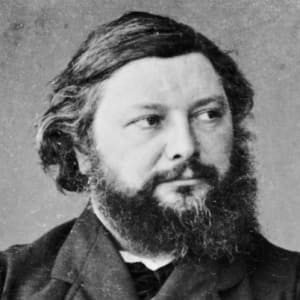
Gustave Courbet was born on June 10, 1819, in Ornans, France. By the 1850s, Courbet was known as a bold new artist in the Realist school, and he shocked critics and the public with his large-scale paintings showing scenes of everyday rural life. Involvement with the Paris Commune of 1871 meant that Courbet spent the last years of his life in exile in Switzerland, where he died on December 31, 1877.
Jean-Désiré-Gustave Courbet, better known as Gustave Courbet, was born on June 10, 1819, in Ornans, a small town in France’s Franche-Comté region. He was the oldest of four children of Eléonor-Régis Courbet, a prosperous farmer and landowner, and Sylvie Courbet.
At the age of 14, Courbet began taking lessons in painting with a local artist called "père" Baud. In 1837, Courbet relocated to Besançon, where he continued to learn about art. He next proceeded to Paris, a move that allowed him to make visits to the Louvre and copy works by artists such as Rembrandt, Peter Paul Rubens, Caravaggio and Francisco de Zurbarán.
In this early stage of his artistic career, Courbet painted a number of self-portraits, including “The Desperate Man” (1841) and “Self-Portrait with a Black Dog” (1842). The latter was accepted into the Salon of 1844, a prestigious, state-sponsored annual exhibition held in Paris.
In 1848, Courbet had a professional breakthrough when ten of his paintings were accepted into the Paris Salon. Being awarded a second-class gold medal the following year meant he was no longer required to submit his paintings to a jury in order for them to be exhibited at the Salon (this special status lasted until a rule change in 1857).
As Courbet established himself in his profession, he also courted controversy through his work. In the Parisian art world of the mid-1800s, the paintings that received the most respect and praise were large scenes of subjects from history, mythology or the Bible. Courbet worked on large canvases, but he chose to depict incidents from the everyday world of the French countryside, such as “The Stone-Breakers,” a scene of two anonymous manual laborers (1849).
Courbet’s “A Burial at Ornans” (1849-50) depicted a funeral in his rural hometown; it puzzled and upset viewers at the Salon of 1851 due to its depiction of ordinary country people on a monumental scale. As France and other European countries had recently been racked by workers’ revolts during the upheavals of 1848, Courbet’s art was also perceived as having a strong political message.
In 1854-55, Courbet painted a large autobiographical work entitled “The Painter’s Studio: A Real Allegory Summing Up a Seven-Year Phase of My Artistic Life.” This nearly 20-foot canvas shows Courbet working at his easel while surrounded by individuals—real and symbolic—who had influenced his life and career (the figures include Courbet's friends Charles Baudelaire and Pierre-Joseph Proudhon). When this painting was rejected by the jury of 1855's Exposition Universelle, Courbet responded by installing it in a show of his own works he held in a nearby pavilion.
Courbet also continued to provoke his audiences by pushing the boundaries of propriety in his art. “Young Women on the Banks of the Seine” (1856) shows two women in disarrayed clothing reclining informally on a riverbank—it shocked many viewers, though the painting was praised by some critics. “The Woman with a Parrot” (1866), a female nude, received a similar reaction.
During the 1860s, which were productive years for Courbet, he also painted less controversial hunting scenes, still lifes and landscapes. In general, his art was met with steady sales and continued acclaim.
Courbet was a lifelong republican whose realistic style of painting and choice of subjects from everyday life corresponded with his political beliefs. After Napoleon III’s rule collapsed in 1870, Courbet supported the republican Paris Commune. But when the Commune came to an end in 1871, he was soon arrested for being involved in the destruction of the Vendôme Column, a symbol of the Napoleonic regime.
Courbet accepted the initial punishment meted out to him for the column's destruction: six months in prison and a small fine. In 1873, being held responsible for the costs of reinstalling the column prompted him to move to Switzerland.
While living in exile, Courbet had little money and began drinking heavily, though he managed to produce some landscapes and portraits. On December 31, 1877, Courbet died at the age of 58 in La Tour-de-Peilz, Switzerland.